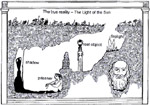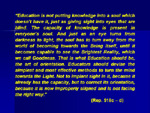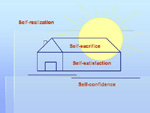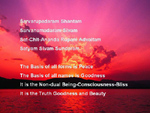|
THE TEACHINGS
OF PLATO ON EDUCATION:
A PARALLELISM WITH SWAMI’S TEACHINGS ON EDUCARE
(Continued from the previous issue)
GOODNESS
After the virtues of the true philosopher have been mentioned,
Plato leads us to the highest point, the knowledge of Goodness
(Sivam). Righteousness, bravery, self control and all the
other virtues are indeed very important, but still there is
something higher. This is the idea of Goodness, God Himself,
who is like the Sun whose rays are the virtues.
“There is absolutely no point
in having expert knowledge of everything else, but lacking
knowledge of Goodness. There is absolutely no advantage in
owning everything else in the world, but not Goodness”
(505a-b).
That is what every soul yearns and makes every effort to own.
Many people are in the dark about it, but we cannot allow
the best members of our community, the ones to whom we are
going to entrust everything, to be equally in the dark. But
what is Goodness?
Socrates professes himself incapable of defining Goodness
and proposes a simile instead, the simile of the Sun. Just
as the sun is the source of light and growth and is responsible
for sight and seeing and is the acme of the visible realm,
so Goodness is the source of Truth and reality and is responsible
for knowledge of all ideas in the invisible world of higher
intellect. To give a clear image of Goodness, Plato introduces
here the famous allegory of the cave (514a – 518b):
“Imagine people
living in a cave down under the ground; at the far end of
the cave there’s an entrance open to the outside world.
They’ve been there since childhood, with their legs
and necks tied up in a way that keeps them in one place and
allows them to look only straight ahead, but not to turn their
heads. There is firelight burning a long way further up the
cave behind them, and up the slope between the fire and the
prisoner there’s a road and beside it a low wall. Imagine
also that there are people on the other side of this wall,
who are carrying all sorts of objects, that stick out over
the wall; and some of these people talk and others are silent.
Do you think these prisoners would see anything of themselves,
of one another or of the objects except the shadows cast by
the fire on to the cave wall directly opposite them, since
they are forced to live without moving their heads? And if
they were able to talk to one another, don’t you think
they would assume that their words applied to what they saw
passing by in front of them? And if sound echoed off the prison
wall opposite them, when any of the passers-by spoke, they
would assume that the sound came from a passing shadow. All
in all then, the shadows of the objects would constitute the
only reality people inside would recognize.
 What
would happen if they were set free from their bonds and cured
of their ignorance? Imagine that one of them is suddenly made
to stand up, to turn his head and walk and to look towards
the firelight. It hurts him to do all this and he is too dazzled
to be capable of making out the objects whose shadows he had
formerly been looking at. And if someone tells him that what
he’s been seeing all this time has no substance and
now he is seeing more accurately, what do you think his reaction
would be? And if he were shown any of the passing objects
and he were asked what it was, he would be bewildered. He
would think that there was more reality in what he had been
seeing before than in what he is seeing now. And if he were
forced to look at the firelight it would hurt his eyes and
he would turn away and run back to the shadows. He would think
that the shadows are clearer than the real objects. And if
someone drugged him forcibly and pulled him out into the sunlight
he would not be able to see a single one of the real things,
because his eyes would be overwhelmed by the sun’s beams.
He wouldn’t be able to see things up on the surface
of the earth until he had got used to the sunlight. At first,
it would be shadows that he could most easily make out, then
he would move on to the reflections in water and later he
would be able to see the actual things themselves. Next, he
would turn his eyes on the heavens, easier at night and he
would look at the light of the stars and the moon. And at
last he would be able to discern and turn his eyes on the
sun during day time. After that he would realize that the
sun is the source of the seasons and the yearly cycle; that
the whole of the visible realm is its domain and that everything
that he used to see is caused by the Sun. And if he recalled
the cave where he had originally lived and his former fellow
prisoners, he would feel happy about his new situation and
sorry for them. And if he went back underground and sat down
again in the same spot, his eyes would be overwhelmed by darkness,
because of the sudden transition from the sunlight. And if
he had to compete against those same old prisoners at identifying
those shadows, they would call him a fool.. They would say
that he had come back from his upward journey with his eyes
ruined and that it wasn’t even worth trying to go up
there. And if anyone tried to set them free and take them
up there, they would grab hold of him –if they could-
and kill him. What
would happen if they were set free from their bonds and cured
of their ignorance? Imagine that one of them is suddenly made
to stand up, to turn his head and walk and to look towards
the firelight. It hurts him to do all this and he is too dazzled
to be capable of making out the objects whose shadows he had
formerly been looking at. And if someone tells him that what
he’s been seeing all this time has no substance and
now he is seeing more accurately, what do you think his reaction
would be? And if he were shown any of the passing objects
and he were asked what it was, he would be bewildered. He
would think that there was more reality in what he had been
seeing before than in what he is seeing now. And if he were
forced to look at the firelight it would hurt his eyes and
he would turn away and run back to the shadows. He would think
that the shadows are clearer than the real objects. And if
someone drugged him forcibly and pulled him out into the sunlight
he would not be able to see a single one of the real things,
because his eyes would be overwhelmed by the sun’s beams.
He wouldn’t be able to see things up on the surface
of the earth until he had got used to the sunlight. At first,
it would be shadows that he could most easily make out, then
he would move on to the reflections in water and later he
would be able to see the actual things themselves. Next, he
would turn his eyes on the heavens, easier at night and he
would look at the light of the stars and the moon. And at
last he would be able to discern and turn his eyes on the
sun during day time. After that he would realize that the
sun is the source of the seasons and the yearly cycle; that
the whole of the visible realm is its domain and that everything
that he used to see is caused by the Sun. And if he recalled
the cave where he had originally lived and his former fellow
prisoners, he would feel happy about his new situation and
sorry for them. And if he went back underground and sat down
again in the same spot, his eyes would be overwhelmed by darkness,
because of the sudden transition from the sunlight. And if
he had to compete against those same old prisoners at identifying
those shadows, they would call him a fool.. They would say
that he had come back from his upward journey with his eyes
ruined and that it wasn’t even worth trying to go up
there. And if anyone tried to set them free and take them
up there, they would grab hold of him –if they could-
and kill him.
You should apply this allegory, to what we were talking about
before. The region that is accessible to sight should be equated
with the prison cave and the firelight there with the light
of the sun. You should think of the upward journey and the
sight of things up on the surface of the earth as the mind’s
ascent to the spiritual realm. The last thing to be seen in
the spiritual realm is Goodness; and the sight of Goodness
leads one to realize that This is responsible for everything
that is right and fine. In the visible realm Goodness is the
progenitor of light and the source of light and in the spiritual
realm, Goodness is the source and provider of Truth and Knowledge.
The sight of It is a prerequisite for Righteousness either
in one’s private affairs or in public business".
(Republic, 514a – 517c)
EDUCATION IS THE TURNING OF THE SOUL
TOWARDS THE LIGHT OF GOODNESS
After this wonderful allegory of the cave
and the description of the upward journey of the Soul towards
Goodness, Plato defines that this is exactly the goal of education.
He says:
 “Education
is not putting knowledge into a soul which doesn’t have
it, just as giving sight into eyes that are blind. The capacity
of knowledge is present in everyone’s soul. And just
as an eye turns from darkness to light, the soul has to turn
away from the world of becoming towards the Being Itself until
it becomes capable to see the Brightest Reality, which we
call Goodness. That’s what Education should be, the
art of orientation. Educators should devise the simplest and
most effective methods to turn the mind towards the Light.
Not to implant sight in it, because it already has the capacity,
but to correct its orientation, because it is now improperly
aligned and is not facing the right way” “Education
is not putting knowledge into a soul which doesn’t have
it, just as giving sight into eyes that are blind. The capacity
of knowledge is present in everyone’s soul. And just
as an eye turns from darkness to light, the soul has to turn
away from the world of becoming towards the Being Itself until
it becomes capable to see the Brightest Reality, which we
call Goodness. That’s what Education should be, the
art of orientation. Educators should devise the simplest and
most effective methods to turn the mind towards the Light.
Not to implant sight in it, because it already has the capacity,
but to correct its orientation, because it is now improperly
aligned and is not facing the right way”
(Republic, 518c – d)
As Swami very simply says:
“Education should not be
information
Education should be transformation” |
|
The ascent of the soul towards the Being
starts with music and gymnastics as we saw earlier. But for
the completion of the journey to Goodness higher education
is needed. The philosophers must study arithmetic, geometry,
solid geometry, astronomy and harmony. Finally after the mind
has been sharpened through them, it is ready for the highest
subject, that is dialectic. Maybe we could ask here how these
subjects that deal with the world of becoming, can help in
the spiritual ascent of the Soul towards Being?
“The study of these subjects purifies
the organ of higher intellect that everyone has, while other
occupations ruin it and blind it. This organ is a thousand
times more precious than any eye, since this is the only organ
that can see Truth” (527e).
The real science is not the science of the mundane world but
spirituality, the science of the Being beyond time and space.
How can the previous subjects help in this science? Plato
says about astronomy: “There is
nothing in the visible realm that is more beautiful than these
decorations in the sky. But since they are within the visible
realm, they should be regarded as considerably inferior to
true decorations, to true Beauty… Therefore, we should
use the heavenly decorations merely as illustrations to help
us study the invisible realm of the Divine… If we don’t
ignore the heavenly bodies, we’ll never be engaged in
true astronomy and we’ll never develop our soul’s
innate intelligence”
(Rep. 529c – 530b).
We see that for Plato the real benefit of
the study of the material world is not to remain trapped in
the external vision, but to be awakened to the Divine Reality
that lies beyond the worldly phenomena. The aim is to see
with the inner eye of wisdom the Divine Beauty that lies behind
the external beauty. To reach at the highest top and to see
Goodness Itself, the last subject is dialectic.
Dialectic is the highest faculty of discrimination between
what is real and what is unreal, what is permanent and what
is transient. (Dialectic = Viveka)
“He who uses dialectic with absolutely
no use of the senses, reaches the summit of the spiritual
realm. He grasps with his intellect the Idea of Goodness Itself,
just as the prisoner of the cave ends up at the supreme point
of the visible realm, that is the Sun” (532a
– b)
“Dialectic uproots the things
that now are taken for granted and leads towards the Primary
Cause. It gently extracts the mind’s eye from the mud
in which it is now buried and guides it upwards.”
(533d)
“So dialectic occupies the highest
position and is the copestone of the curriculum. There is
no subject higher than this and therefore dialectic completes
our educational program.” (534e)
Until now we saw in brief the educational program that Plato
establishes in an ideal community. This is exactly the same
with the one that Bhagavan Baba has established all over the
world with the program of Education in Human Values.
The foundation of this program is Self-confidence,
that is the strong faith in the spiritual nature of man, the
 faith
that his real self is the Divine Self, Atma, who indwells
in the vehicle of body and mind. The purpose of the ideal
education is to remind to man this Divine Nature of his. faith
that his real self is the Divine Self, Atma, who indwells
in the vehicle of body and mind. The purpose of the ideal
education is to remind to man this Divine Nature of his.
To reach this
Divine End, man has to build the mansion of his life with
the walls of Self-satisfaction,
that means to learn to draw happiness from his inner Self.
Then he has to build the roof of self-sacrifice;
when he is established in his real spiritual Self, then he
can sacrifice outer things for the welfare of his fellow beings.
Finally, in this mansion the Light of Self-realization,
the Light of Goodness, will shine.
Many times Swami in His discourses speaks about
Socrates, Plato and Aristotle. Here is an extract
from a discourse delivered by Bhagavan Sri Satya
Sai Baba to the faculty and students of Sri Satya
Sai Institute of Higher Learning, Prashanti Nilayam.
“Socrates used to follow
the path of Pariprasna
– asking questions and answering them. This
encouraged the whole youth. What are the characteristics
of a ruler? What good qualities and habits should
he have? What morals should he follow? What type
of devotion should he have? He used to inquire
in all these things. He made the youth think about
these things and finally it was decided that the
person without these qualities was not fit to
be a ruler. He should have love for God. It was
decided that the youth should fight for the country.
The rulers of his time were very annoyed about
this, hence decided to sentence Socrates to death.
Good always faces obstacles like this. The decision
was final. Nobody could change it. Socrates decided
it was better to die in the hands of his devotees
rather than in the hands of the rulers.
 The
first disciple of Socrates was Plato. Plato was
a very mighty person. Plato tried to spread the
teachings of Socrates all over the world. He preached
that for this world three things are important
and necessary: Truth, Goodness and Beauty. What
is Beauty? Beauty is not related to the body.
Selflessness is beauty. A person who works selflessly
is the most beautiful one. These three are also
called Nischala (steadiness),
Nirmala (purity)
Nisvartha (selflessness). The
first disciple of Socrates was Plato. Plato was
a very mighty person. Plato tried to spread the
teachings of Socrates all over the world. He preached
that for this world three things are important
and necessary: Truth, Goodness and Beauty. What
is Beauty? Beauty is not related to the body.
Selflessness is beauty. A person who works selflessly
is the most beautiful one. These three are also
called Nischala (steadiness),
Nirmala (purity)
Nisvartha (selflessness).
Aristotle, the disciple of Plato
had good acquaintance with Indian culture. He
took those three words of Plato and reformed them
as Satyam Sivam and Sundaram. He taught to the
world that Satyam
(Truth), Sivam (Goodness)
and Sundaram (Beauty)
are very important. These three are the teachings
of Satya Sai also. Satyam:
speak truth, Sivam: mangalam
(auspiciousness). What is auspiciousness? Selflessness
is auspiciousness. If anything is selfish, it
becomes amangalam
(inauspicious). Then comes Sundaram:
Beauty. When will anything be beautiful? Anything
will be beautiful when there is no trace of attachment.
Plato developed all these things. When a country
is developed like this, then people can enjoy
the fruits of this. The culture that Plato and
others followed is also Bharathiya
culture.” |
|
|
